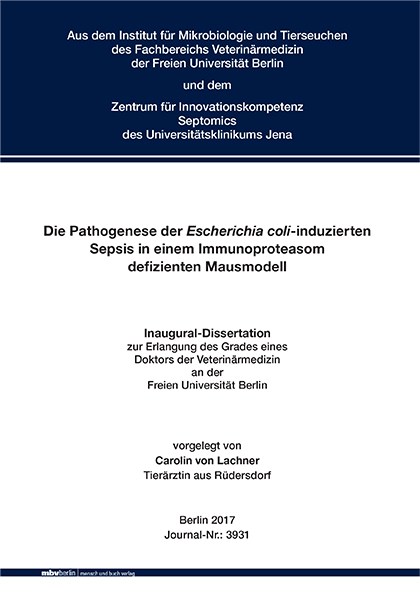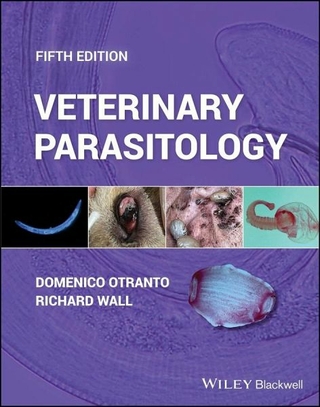
Die Pathogenese der Escherichia coli-induzierten Sepsis in einem Immunoproteasom defizienten Mausmodell
Seiten
2018
|
1. Aufl.
Mensch & Buch (Verlag)
978-3-86387-876-4 (ISBN)
Mensch & Buch (Verlag)
978-3-86387-876-4 (ISBN)
- Keine Verlagsinformationen verfügbar
- Artikel merken
The Pathogenesis of Escherichia coli induces Sepsis in an immunoproteasome deficient mouse model
Sepsis is a life threatening organ dysfunction induced by a dysregulated immune reaction on an infectious agent and is the main reason for complications in intensive care units worldwide. Moreover, the septic shock, a sepsis underlying event caused by particularly profound circulatory, cellular and metabolic abnormalities is responsible for an in-hospital-mortality of al most 40 %. The incidence of this complex syndrome is rising due to sensitive diagnostics and the increasing rate of older and co-morbidity patients. Even successfully treated patients who survived sepsis suffer from long-time health restrictions. While sepsis is underestimated in public mind, it is a main issue in science due to the lack of adequate therapy options. Despite intense research it is of continual interest to find new results which are able to explain the diverse and complicated pathogenesis of sepsis and septic shock. This study is investigating the pathogenesis of the Gram-negative sepsis with the focus on an immune relevant subtype of the proteasome in a murine infection model. The proteasome is the major non-lysosomal protein degradation machinery in eukaryotic cells. Interferon γ and lipopolysaccharide, a cell wall component of gram-negative bacteria, cause a change in proteasome de novo composition and lead to an incorporation of proteolytic higher active immunosubunits. This study is investigating the immune modulatory function of this newly synthesized so called immunoproteasome (i-proteasome) during the infection of i-proteasome-knock-out-mice with Escherichia coli, the major representative pathogen causing Gram-negative sepsis. We observed severe symptoms and particularly profound organ damage in i-proteasome-knockout- mice forcing a multi-organ dysfunction syndrome and an accelerated lethality, indicating the crucial role of the i-proteasome during the pathogenesis of sepsis in this model. Nevertheless, neither the deficient eradication of this bacterial agent nor the higher bacterial burden found in the whole organism of knock-out-animals could be explained due to impaired function and quantity of innate immune cells at the site of infection. Furthermore, we noticed an unrestricted systemic production of pro- and anti-inflammatory mediators in i-proteasomeknock-out-mice. However, we identified an impaired lymphocytic immune response characterized by reduced lymphocyte counts and a diminished MHC-II-expression on B-cells of i-proteasome-knock-out-animals. Additionally, analyses of gene-expression in liver tissue of septic animals indicated differences in the transcriptomic profile between wild-type and iproteasome-knock-out-animals regarding groups of genes associated with angiogenesis, wound healing and apoptosis. These findings offer new insights in the immune modulatory role of the i-proteasome in Gram-negative sepsis and raise the hypothesis of a cell- and tissue specific function of the i-proteasome. Experiments of this study highlighted the protective character of the i-proteasome, particularly the immunosubunit Multicatalytic Endopeptidase Complex-1 (MECL-1) during the pathogenesis of Escherichia coli induced sepsis. As a consequence of this work we can conclude that the selective inhibition of the i-proteasome might not be a successful and clinically relevant pharmacological target to treat Gram-negative sepsis. Das Krankheitsbild der Sepsis, definiert als eine lebensbedrohliche Organdysfunktion, verursacht durch eine dysregulierte Immunantwort auf eine Infektion, stellt weltweit die häufigste Komplikation auf Intensivstationen dar. Der septische Schock, ein dem komplexen Krankheitssyndrom unterliegendes Ereignis, welches sich durch besonders schwere zirkulatorische, zelluläre und metabolische Abnormalitäten auszeichnet, ist zudem mit einer Mortalität von bis zu 40 % assoziiert. Eine sensitivere Diagnostik, das steigende Alter sowie häufig auftretende Komorbiditäten der Patienten führen zu einer steigenden Inzidenz der Erkrankung. Weiterhin zieht die Sepsis auch in erfolgreich therapierten Patienten schwerwiegende gesundheitliche Probleme nach sich. Unabhängig von der öffentlichen Meinung, welche die Sepsis zuweilen unterschätzt, rückt das Krankheitsbild durch einen Mangel an adäquaten Therapieoptionen in den Fokus der Wissenschaft. Trotz intensiver Forschung besteht ein beständiges Interesse an neuen Erkenntnissen, welche die vielfältige und komplizierte Pathogenese der Sepsis erklären könnten. In dieser Studie soll durch ein murines Infektionsmodell die Pathogenese der Sepsis, induziert durch eine Peritonitis, in Bezug auf die immunologisch relevante Sonderform des Proteasoms betrachtet werden. Das Proteasom, der wichtigste proteolytische Enzymkomplex des nicht lysosomalen Proteinabbaus eukaryotischer Zellen, ist unter Einfluss von Interferon γ und Lipopolysaccharid, einem Zellwandbestandteil Gram-negativer Bakterien, befähigt, proteolytisch aktivere Immunountereinheiten einzubauen. Welche immunmodulatorischen Funktionen das neu gebildete Immunoproteasom (IProteasom) besitzt, wurde in dieser Studie durch Escherichia coli-infizierte I-Proteasomdefiziente Mäuse für die Gram-negative Sepsis beschrieben. Die zentrale Rolle des IProteasoms wurde durch eine verstärkte Symptomatik und Organpathologie in I-Proteasom-Knock-Out-Mäusen, welche letztlich in einem forcierten Multi-Organ-Dysfunktions-Syndrom und einer erhöhten Letalität gipfelten, deutlich. Eine verminderte Eradikation der Erreger und die erhöhte bakterielle Last im gesamten Organismus konnte jedoch nicht mit einer eingeschränkten Funktionalität von Zellen des angeborenen Immunsystems am Infektionsort erklärt werden. Neben der uneingeschränkten Produktion systemisch wirkender pro- und antiinflammatorischer Mediatoren wurde in I-Proteasom-Knock-Out-Tieren jedoch eine verminderte lymphozytäre Abwehr detektiert, welche sich in einer ausgeprägteren Lymphopenie und einer eingeschränkten Expression von MHC-II-Molekülen auf B-Zellen der Knock-Out-Tiere manifestierte. Desweiteren ergaben Analysen der Genexpression von Lebergewebe septischer Tiere Unterschiede im Transkriptomprofil zwischen Wildtyp- und IProteasom-Knock-Out-Mäusen. Der Einfluss des I-Proteasoms auf die Regulation von Genkomplexen unter anderem die Angiogenese, Wundheilung und Apoptose betreffend, ermöglicht eine neue Sicht auf die Rolle des I-Proteasoms in Immunreaktionen und gibt Hinweise auf eine zell- und gewebsspezifische Funktionalität. Durch die Versuche dieser Studie wurde ein umfassendes Bild des protektiven Charakters des I-Proteasoms und im Besonderen der Immunountereinheit Multicatalytic Endopeptidase Complex-1 (MECL-1) in der Escherichia coli-induzierten Sepsis dargestellt. Somit stellt die selektive Hemmung des IProteasoms in der Behandlungsstrategie der Gram-negativen Sepsis höchstwahrscheinlich kein klinisch relevantes pharmakologisches Ziel dar.
Sepsis is a life threatening organ dysfunction induced by a dysregulated immune reaction on an infectious agent and is the main reason for complications in intensive care units worldwide. Moreover, the septic shock, a sepsis underlying event caused by particularly profound circulatory, cellular and metabolic abnormalities is responsible for an in-hospital-mortality of al most 40 %. The incidence of this complex syndrome is rising due to sensitive diagnostics and the increasing rate of older and co-morbidity patients. Even successfully treated patients who survived sepsis suffer from long-time health restrictions. While sepsis is underestimated in public mind, it is a main issue in science due to the lack of adequate therapy options. Despite intense research it is of continual interest to find new results which are able to explain the diverse and complicated pathogenesis of sepsis and septic shock. This study is investigating the pathogenesis of the Gram-negative sepsis with the focus on an immune relevant subtype of the proteasome in a murine infection model. The proteasome is the major non-lysosomal protein degradation machinery in eukaryotic cells. Interferon γ and lipopolysaccharide, a cell wall component of gram-negative bacteria, cause a change in proteasome de novo composition and lead to an incorporation of proteolytic higher active immunosubunits. This study is investigating the immune modulatory function of this newly synthesized so called immunoproteasome (i-proteasome) during the infection of i-proteasome-knock-out-mice with Escherichia coli, the major representative pathogen causing Gram-negative sepsis. We observed severe symptoms and particularly profound organ damage in i-proteasome-knockout- mice forcing a multi-organ dysfunction syndrome and an accelerated lethality, indicating the crucial role of the i-proteasome during the pathogenesis of sepsis in this model. Nevertheless, neither the deficient eradication of this bacterial agent nor the higher bacterial burden found in the whole organism of knock-out-animals could be explained due to impaired function and quantity of innate immune cells at the site of infection. Furthermore, we noticed an unrestricted systemic production of pro- and anti-inflammatory mediators in i-proteasomeknock-out-mice. However, we identified an impaired lymphocytic immune response characterized by reduced lymphocyte counts and a diminished MHC-II-expression on B-cells of i-proteasome-knock-out-animals. Additionally, analyses of gene-expression in liver tissue of septic animals indicated differences in the transcriptomic profile between wild-type and iproteasome-knock-out-animals regarding groups of genes associated with angiogenesis, wound healing and apoptosis. These findings offer new insights in the immune modulatory role of the i-proteasome in Gram-negative sepsis and raise the hypothesis of a cell- and tissue specific function of the i-proteasome. Experiments of this study highlighted the protective character of the i-proteasome, particularly the immunosubunit Multicatalytic Endopeptidase Complex-1 (MECL-1) during the pathogenesis of Escherichia coli induced sepsis. As a consequence of this work we can conclude that the selective inhibition of the i-proteasome might not be a successful and clinically relevant pharmacological target to treat Gram-negative sepsis. Das Krankheitsbild der Sepsis, definiert als eine lebensbedrohliche Organdysfunktion, verursacht durch eine dysregulierte Immunantwort auf eine Infektion, stellt weltweit die häufigste Komplikation auf Intensivstationen dar. Der septische Schock, ein dem komplexen Krankheitssyndrom unterliegendes Ereignis, welches sich durch besonders schwere zirkulatorische, zelluläre und metabolische Abnormalitäten auszeichnet, ist zudem mit einer Mortalität von bis zu 40 % assoziiert. Eine sensitivere Diagnostik, das steigende Alter sowie häufig auftretende Komorbiditäten der Patienten führen zu einer steigenden Inzidenz der Erkrankung. Weiterhin zieht die Sepsis auch in erfolgreich therapierten Patienten schwerwiegende gesundheitliche Probleme nach sich. Unabhängig von der öffentlichen Meinung, welche die Sepsis zuweilen unterschätzt, rückt das Krankheitsbild durch einen Mangel an adäquaten Therapieoptionen in den Fokus der Wissenschaft. Trotz intensiver Forschung besteht ein beständiges Interesse an neuen Erkenntnissen, welche die vielfältige und komplizierte Pathogenese der Sepsis erklären könnten. In dieser Studie soll durch ein murines Infektionsmodell die Pathogenese der Sepsis, induziert durch eine Peritonitis, in Bezug auf die immunologisch relevante Sonderform des Proteasoms betrachtet werden. Das Proteasom, der wichtigste proteolytische Enzymkomplex des nicht lysosomalen Proteinabbaus eukaryotischer Zellen, ist unter Einfluss von Interferon γ und Lipopolysaccharid, einem Zellwandbestandteil Gram-negativer Bakterien, befähigt, proteolytisch aktivere Immunountereinheiten einzubauen. Welche immunmodulatorischen Funktionen das neu gebildete Immunoproteasom (IProteasom) besitzt, wurde in dieser Studie durch Escherichia coli-infizierte I-Proteasomdefiziente Mäuse für die Gram-negative Sepsis beschrieben. Die zentrale Rolle des IProteasoms wurde durch eine verstärkte Symptomatik und Organpathologie in I-Proteasom-Knock-Out-Mäusen, welche letztlich in einem forcierten Multi-Organ-Dysfunktions-Syndrom und einer erhöhten Letalität gipfelten, deutlich. Eine verminderte Eradikation der Erreger und die erhöhte bakterielle Last im gesamten Organismus konnte jedoch nicht mit einer eingeschränkten Funktionalität von Zellen des angeborenen Immunsystems am Infektionsort erklärt werden. Neben der uneingeschränkten Produktion systemisch wirkender pro- und antiinflammatorischer Mediatoren wurde in I-Proteasom-Knock-Out-Tieren jedoch eine verminderte lymphozytäre Abwehr detektiert, welche sich in einer ausgeprägteren Lymphopenie und einer eingeschränkten Expression von MHC-II-Molekülen auf B-Zellen der Knock-Out-Tiere manifestierte. Desweiteren ergaben Analysen der Genexpression von Lebergewebe septischer Tiere Unterschiede im Transkriptomprofil zwischen Wildtyp- und IProteasom-Knock-Out-Mäusen. Der Einfluss des I-Proteasoms auf die Regulation von Genkomplexen unter anderem die Angiogenese, Wundheilung und Apoptose betreffend, ermöglicht eine neue Sicht auf die Rolle des I-Proteasoms in Immunreaktionen und gibt Hinweise auf eine zell- und gewebsspezifische Funktionalität. Durch die Versuche dieser Studie wurde ein umfassendes Bild des protektiven Charakters des I-Proteasoms und im Besonderen der Immunountereinheit Multicatalytic Endopeptidase Complex-1 (MECL-1) in der Escherichia coli-induzierten Sepsis dargestellt. Somit stellt die selektive Hemmung des IProteasoms in der Behandlungsstrategie der Gram-negativen Sepsis höchstwahrscheinlich kein klinisch relevantes pharmakologisches Ziel dar.
| Erscheinungsdatum | 27.09.2018 |
|---|---|
| Verlagsort | Berlin |
| Sprache | deutsch |
| Maße | 148 x 210 mm |
| Themenwelt | Veterinärmedizin ► Klinische Fächer ► Parasitologie |
| Schlagworte | Animal Models • ELISA • Endopeptidases • Escherichia coli • Immunoassay • Immunoblotting • immunology • inflammation • Mesh • mice • Pathology • peritonitis • Polymerase chain reaction • proteasome endopeptidase complex • Protein degradation • Sepsis |
| ISBN-10 | 3-86387-876-0 / 3863878760 |
| ISBN-13 | 978-3-86387-876-4 / 9783863878764 |
| Zustand | Neuware |
| Informationen gemäß Produktsicherheitsverordnung (GPSR) | |
| Haben Sie eine Frage zum Produkt? |
Mehr entdecken
aus dem Bereich
aus dem Bereich
Buch | Spiralbindung (2023)
Schlütersche (Verlag)
179,00 €


